1997 PONTIAC GRAND AM fuse
[x] Cancel search: fusePage 6 of 371
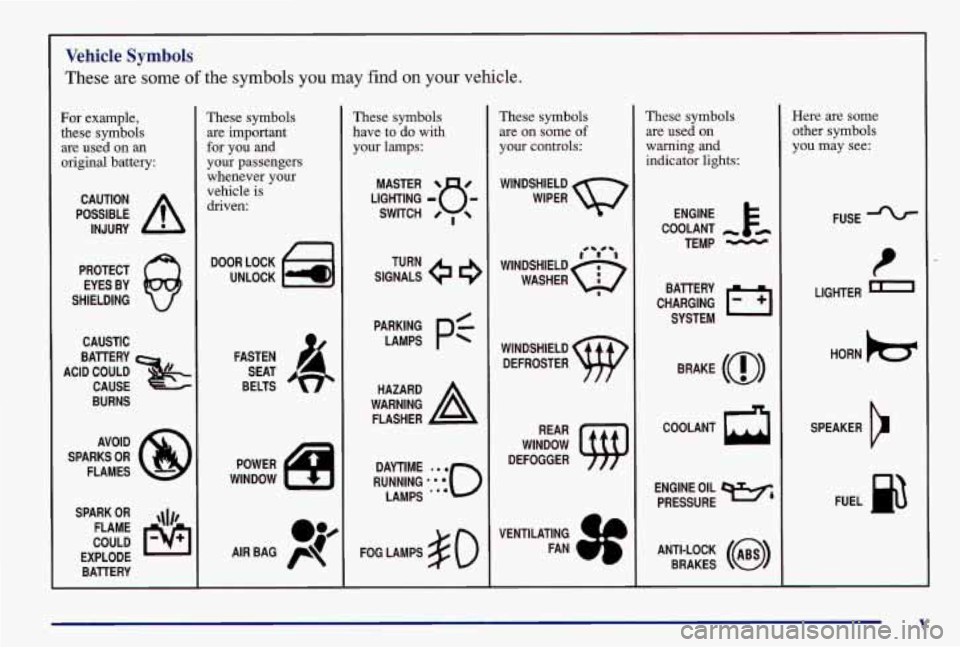
Vehicle Symbols
These are some of the symbols you may find on your vehicle.
For example,
these symbols are used on
an
original battery:
POSSIBLE A
CAUTION
INJURY
PROTECT EYES BY
SHIELDING
CAUSTIC
ACID COULD BATTERY
CAUSE
BURNS
SPARK
OR ,\I/,
COULD FLAME
EXPLODE BA'ITERY
These symbols
are important
for you and
your passengers whenever your
vehicle is
driven:
DOOR LOCK
UNLOCK
FASTEN SEAT
BELTS
These symbols
have to do with
your lamps:
SIGNALS e
TURN
FOG LAMPS
$0
These symbols
are on some
of
your controls:
WINDSHIELD
WIPER
WINDSHIELD DEFROSTER
These symbols
are used
on
warning and
indicator lights:
COOLANT -
TEMP -
CHARGING I-1
BA'ITERY
SYSTEM
BRAKE
(a)
COOLANT a
ENGINE OIL w,
PRESSURE
ANTI-LOCK
(@)
BRAKES
Here are some
other symbols
you may see:
FUSE -%-
t
LIGHTER n
HORN )tr
SPEAKER
b
FUEL m
V
Page 9 of 371
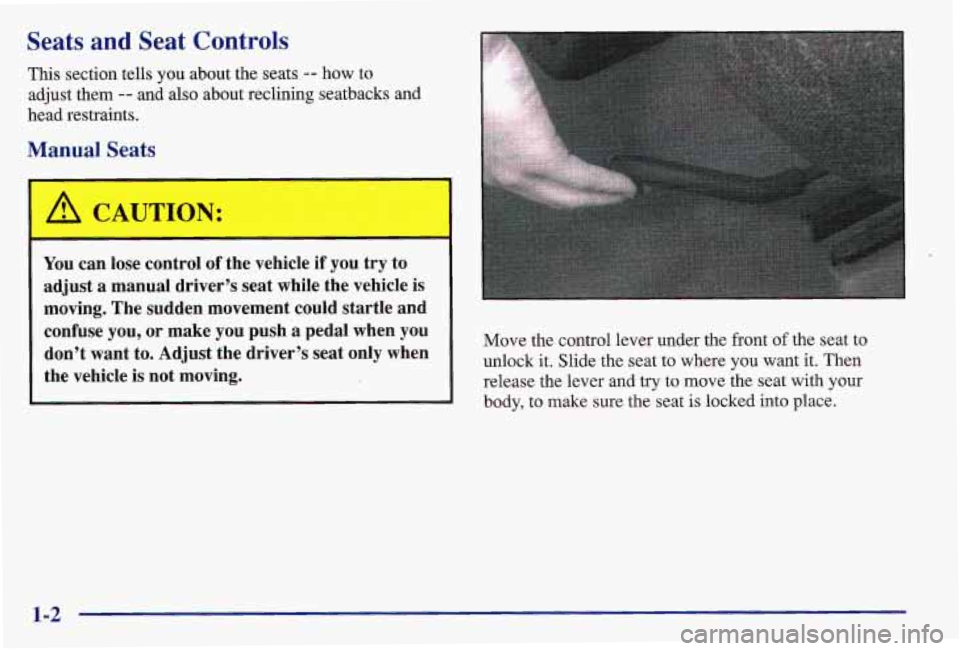
Seats and Seat Controls
This section tells you about the seats -- how to
adjust them
-- and also about reclining seatbacks and
head restraints.
Manual Seats
You can lose control of the vehicle if you try to
adjust
a manual driver’s seat while the vehicle is
moving. The sudden movement could startle and
confuse you, or make you push
a pedal when you
don’t want to. Adjust the driver’s seat only when
the vehicle is not moving. Move the control lever under the front
of the seat to
unlock
it. Slide the seat to where you want it. Then
release the lever and
try to move the seat with your
I body, to make sure the-seat is locked into place.
1-2
Page 60 of 371
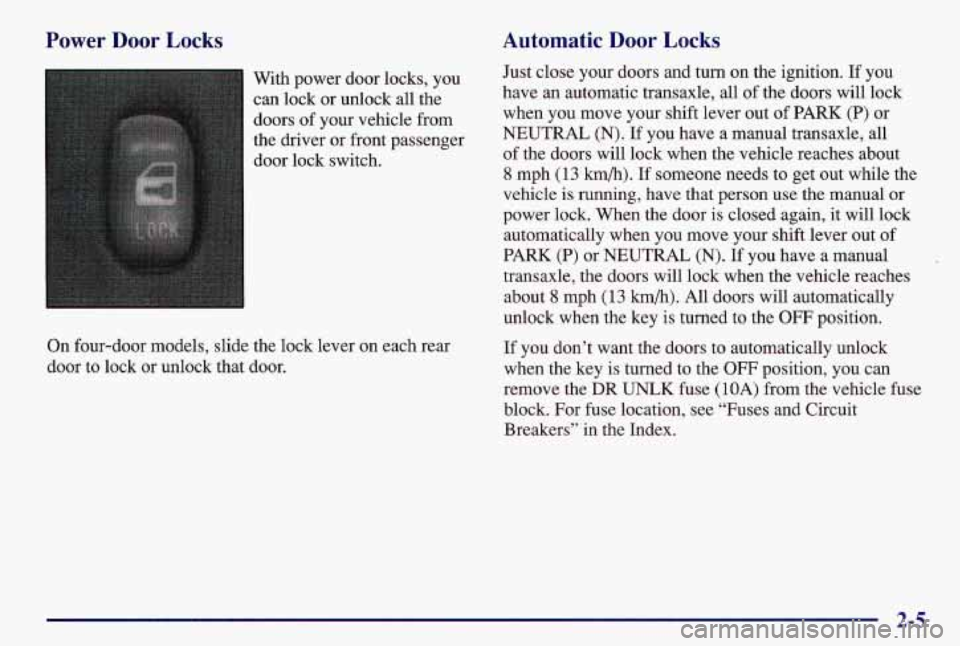
Power Door Locks
With power door locks, you
can lock or unlock all the
doors of your vehicle from
the driver or front passenger door lock switch.
On four-door models, slide the lock lever on each rear
door to lock or unlock that door.
Automatic Door Locks
Just close your doors and turn on the ignition. If you
have an automatic transaxle, all of the doors will lock
when
you move your shift lever out of PARK (P) or
NEUTRAL (N). If you have a manual transaxle, all
of the doors will lock when the vehicle reaches about
8 mph (13 km/h). If someone needs to get out while the
vehicle is running, have that person use the manual or
power lock. When the door is closed again,
it will lock
automatically when you move your shift lever out
of
PARK (P) or NEUTRAL (N). If you have a manual
transaxle, the doors will lock when the vehicle reaches about
8 mph (13 km/h). All doors will automatically
unlock when the key
is turned to the OFF position.
If you don’t want the doors to automatically unlock
when the key
is turned to the OFF position, you can
remove the DR UNLK fuse (1OA) from the vehicle fuse
block. For fuse location, see “Fuses and Circuit
Breakers” in the Index.
2-5
Page 68 of 371

Passlock TM
Your vehicle is equipped with the Passlock
theft-deterrent system.
Passlock is a passive theft-deterrent system. The system is
armed once the key is removed from the ignition. Passlock
enables fuel if the ignition lock cylinder is turned with a valid key.
If a correct key is not used, fuel is disabled,
During normal operation, the THEFT SYS light will go
off after the engine is started. If the engine stalls and the
THEFT SYS light flashes, wait until the light stops
flashing before trying to restart the engine. Remember to
release the key from the START position as soon as the
engine starts. If you are driving and the THEFT
SYS
light comes on, you will be able to restart the engine if
you turn the engine off. However, your Passlock system
is not working properly and must be serviced by your
dealer. Your vehicle is not protected by Passlock at this
time.
You may also want to check the fuse (see “Fuses
and Circuit Breakers” in the Index). See your Pontiac
dealer for service.
If the THEFT SYS light comes on while the engine is
running,
a problem has been detected and the system
may need service. See your dealer for service.
In an emergency, call the Pontiac Roadside Assistance
Center at 1-800-ROADSIB or 1-800-762-3743.
New Vehicle “Break-InSS
NOTICE:
Your modern Pontiac doesn’t need an elaborate
“break-in,” But it will perform better in the long
run
if you follow these guidelines:
0
0
0
Don’t drive at any one speed -- fast or
slow
-- for the first 500 miles (805 km).
Don’t make full-throttle starts,
Avoid making hard stops for the first
200 miles (322 km) or so, During this time
your new brake linings aren’t yet broken
in. Hard stops with new linings can mean
premature wear and earlier replacement.
Follow this breaking-in guideline every
time you get new brake linings,
Don’t tow
a trailer during break-in,
See “Towing a Trailer” in the Index for
more information.
2-13
Page 91 of 371

Turn and Lane Change Signals
The turn signal has two upward (for right) and two
downward (for left) positions. These positions allow you
to signal a turn or a lane change.
To signal a turn, move the lever all the way up or down.
When the turn is finished, the lever will return
automatically.
An arrow on the instrument
panel will flash in the
direction of the turn or
lane change.
To signal a lane change, just raise or lower the lever
until the arrow starts to flash. Hold it there until you
complete your lane change. The lever will return by
itself when you release it.
A warning chime signal will come on
if you have left
your turn signal on for more than
3/4 mile (1 km).
As you signal a turn or a lane change, if the arrows flash
rapidly, a signal bulb may be burned out and other
drivers won’t see your turn signal.
If a bulb is burned out, replace it to help avoid an
accident. If the arrows don’t go on at all when you
signal a turn, check the fuse (see “Fuses and Circuit
Breakers” in the Index). If the arrows still do not flash,
have your Pontiac Dealer service department check the
bulb in the instrument panel.
Headlamp High/Low Beam
To change the headlamps
from low beam to high or
high to low, pull the turn
signal lever all the way
toward you. Then release it.
When the high beams are
on, a light on the instrument
panel
also will be on.
The headlamp high/low beam indicator may flash
if the
Daytime Running Lamps (DRL) system is experiencing
a problem
or if a headlamp is malfunctioning.
2-36
Page 107 of 371
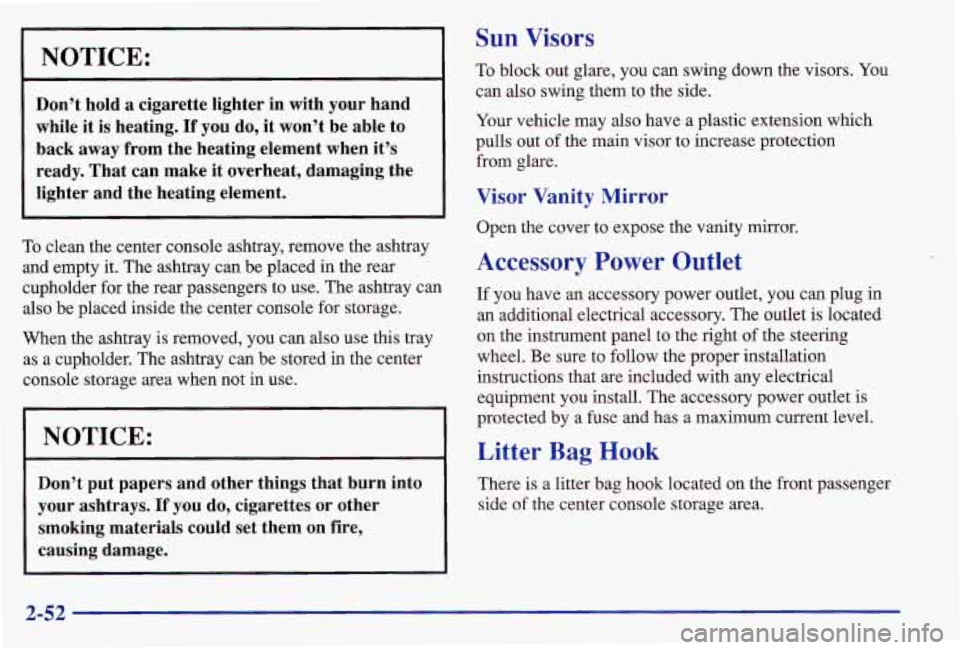
NOTICE:
Don’t hold a cigarette lighter in with your hand
while it is heating, If you do, it won’t be able to
back away from the heating element when it’s ready. That can make it overheat, damaging the
lighter and the heating element.
To clean the center console ashtray, remove the ashtray
and empty it. The ashtray can be placed
in the rear
cupholder for the rear passengers to use. The ashtray can
also be placed inside the center console for storage.
When the ashtray
is removed, you can also use this tray
as a cupholder. The ashtray can be stored in the center
console storage area when not in use.
NOTICE:
Don’t put papers and other things that burn into
your ashtrays. If
you do, cigarettes or other
smoking materials could set them
on fire,
causing damage.
Sun Visors
To block out glare, you can swing down the visors. You
can also swing them to the side.
Your vehicle may also have a plastic extension which
pulls out of the main visor to increase protection
from glare.
Visor Vanity Mirror
Open the cover to expose the vanity mirror.
Accessory Power Outlet
If you have an accessory power outlet, you can plug in
an additional electrical accessory. The outlet is located
on the instrument panel to the right of the steering
wheel. Be sure to follow the proper installation
instructions that are included with any electrical
equipment you install. The accessory power outlet is
protected by a fuse and has a maximum current level.
Litter Bag Hook
There is a litter bag hook located on the front passenger
side
of the center console storage area.
2-52
Page 110 of 371

Your instrument panel is designed to let you know at a glance how your vehicle is running. You’ll know how fast
you’re going, how much fuel you’re using, and many other things you’ll need to drive safely and economically.
The main components
of your instrument panel are:
A. Fuse Panel
B. Vent
C. Turn SignalMultifunction Lever
D. Supplemental Restraint System (SRS)
E. Hazard Warning Flashers Switch
E Instrument Cluster
G. Windshield WipersNasher Stalk
H. Audio System
I. Side Window Defogger Vent
J. Glove Box
K. Climate Control System L. Gear Shift Lever
M. Cupholder/Ashtray
(If Equipped)
N. Enhanced Traction System (ETS) Switch
0. Accessory Power Outleaighter (If Equipped)
(If Equipped)
P. Ignition Switch
Q. Tilt Steering Wheel Lever (If Equipped)
R. Fog Lamp Switch
S. Instrument Panel Intensity Controlhterior
Lamps Switch
T. Hood Release Handle
2-55
Page 182 of 371
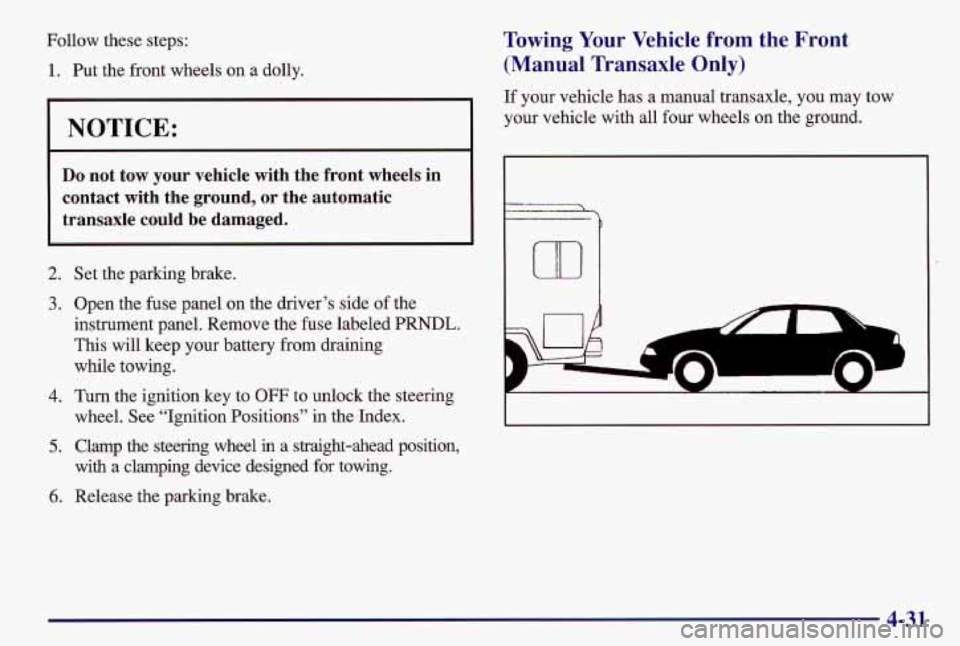
Follow these steps:
1. Put the front wheels on a dolly.
NOTICE:
Do not tow your vehicle with the front wheels in
contact with the
ground, or the automatic
transaxle could be damaged.
2.
3.
4.
5.
6.
Set the parking brake.
Open the fuse panel on the driver’s side of the
instrument panel. Remove the fuse labeled
PRNDL.
This will keep your battery from draining
while towing.
Turn the ignition key to
OFF to unlock the steering
wheel. See “Ignition Positions” in the Index.
Clamp the steering wheel
in a straight-ahead position,
with a clamping device designed for towing.
Release the parking brake.
Towing Your Vehicle from the Front
(Manual Transaxle Only)
If your vehicle has a manual transaxle, you may tow
your vehicle with all four wheels on the ground.
4-31